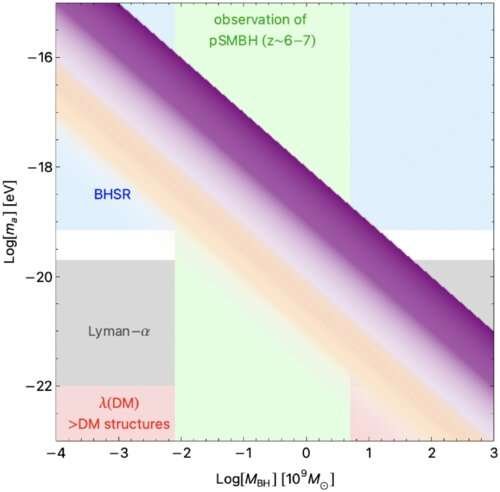The dark side of the universe: How black holes became supermassive
Black holes are among the most compelling mysteries of the universe. Nothing, not even light, can escape a black hole. And at the center of nearly every galaxy, there is a supermassive black hole that's millions to billions of times more massive than the sun. Understanding black holes, and how they become supermassive, could shed light on the evolution of the universe.

Black holes are among the foremost compelling mysteries of the universe. Nothing, not even lightweight, will escape apart. And at the middle of nearly every galaxy, there's a supermassive part that is millions to billions of times a lot huge than the sun. Understanding black holes, and the way they become supermassive, might shed light-weight on the evolution of the universe.
Three physicists at the U.S. Department of Energy's (DOE) Brookhaven National Laboratory have recently developed a model to elucidate the formation of supermassive black holes, further because of the nature of another phenomenon: substance. in an exceedingly paper revealed in Physical Review Letters, theoretical physicists Hooman Davoudiasl, Peter Denton, and Julia Gehrlein describe a cosmological natural action that expedited the formation of supermassive black holes in an exceedingly dark sector of the universe.
A cosmological natural action is comparable to a lot of acquainted variety of part transition: transportation water to a boil. once the water reaches the precise right temperature, it erupts into bubbles and vapor. Imagine that method going down with a primal state of matter. Then, shift the method in reverse therefore it's a cooling result and amplify it to the size of the universe.
"Before galaxies existed, the universe was hot and dense, which is well established. however the universe cooled all the way down to what we have a tendency to observe nowadays may be a matter of interest as a result of we do not have experimental knowledge describing however that happened," same Peter Denton. "We will predict what happened with the famed particles as a result of they act typically. however what if there are not-yet-known particles out there playing differently?"
To explore this question, the Brookhaven team developed a model for a dark sector of the universe, wherever yet-to-be-discovered particles abound and infrequently act. Among these particles may be an ultralight substance, expected to be twenty-eight orders of magnitude lighter than a nucleon. the substance has ne'er been directly determined, however, physicists believe it makes up most of the universe's matter supported its gravitative effects.
"The frequency of interactions between famed particles suggests matter, as we all know it, wouldn't have folded into black holes terribly with efficiency," Denton same. "But, if there was a dark sector with ultralight substance, the first universe may need to be had simply the correct conditions for a really economical style of collapse."
Recent observations have prompted supermassive black holes shaped within the early universe, abundant before physicists antecedently thought. This finding leaves very little time to account for the expansion of supermassive black holes. Physicists understand that black holes acquire mass primarily by 2 means that. One way, known as accretion, once matters, principally dirt, fall into black holes. however, there is a limit to the speed by that matter will accumulate in black holes through accretion. The second method is thru galactic collisions, throughout that 2 black holes will merge; but, within the early universe, galaxies were simply beginning to kind. So, physicists are left inquisitive however these ancient cosmological wonders grew therefore huge therefore quickly. Ultralight substance particles may be the missing piece.
"We theorized however particles within the dark sector might bear a natural action that permits bear on terribly with efficiency collapse into black holes," Denton same. "When the temperature of the universe is simply right, the pressure will suddenly drop to a really low level, permitting gravity to require over and bear on collapse. Our understanding of famed particles indicates that this method would not unremarkably happen."
Such a natural action would be an episode, even for one thing as spectacular because of the universe.
"These collapses are an enormous deal. They emit gravitative waves," Denton same. "Those waves have a characteristic form, therefore we have a tendency to build a prediction for that signal and its expected frequency vary."
Current gravitative wave experiments are not sensitive enough to validate the speculation, however, next-generation experiments are also able to sight signals of these waves. And supported the waves' characteristic form, physicists might then slender in on the main points of supermassive part formation. Until then, Brookhaven theorists can still judge new knowledge and refine their model.
What's Your Reaction?




















